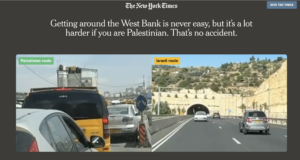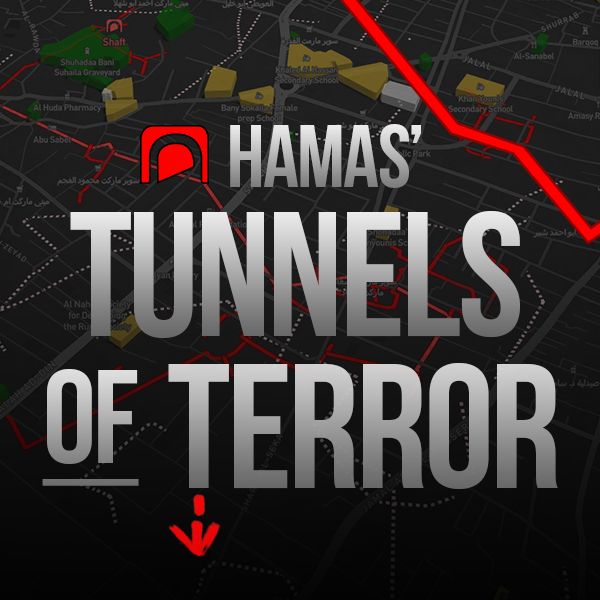The interactive feature titled “Roadblocked,” published by The New York Times, is a visually striking and evidently resource-intensive project. With no fewer than five journalists’ bylines at the top and additional reporting from two others on the ground in Israel, the 3,000-word piece comprises maps, videos, photos, and plenty of cherry-picked quotations that supposedly illustrate the system of “separate but unequal roadways” in the West Bank.
“In the occupied West Bank, Israelis zip along well-groomed roads designed for their convenience,” the piece opens. “Palestinians are shunted onto convoluted routes dotted with checkpoints.”
We are soon introduced to an Israeli and Palestinian, each living in the West Bank, whose daily commutes are presented as symbolic of this allegedly discriminatory road system. The piece then asserts that since the October 7 Hamas attacks, the roads have become “more perilous for Palestinians” due to the threat of “Israeli settlers sometimes attacking Palestinian drivers.”

But because this is The New York Times, a publication that has repeatedly demonstrated its tendency to downplay or outright dismiss Israel’s legitimate security concerns, little attention is paid to the real reason these roads are designed in the way they are.
For example, a caption accompanying a map showing the diverging routes taken by Palestinian and Israeli drivers claims that the barriers and detours are “rooted in Israel’s decades-long efforts to restrict Palestinian movement, prevent attacks on Israelis and increase the Jewish presence in the West Bank, which Israel has occupied since the 1967 war.”
The implication that Israel’s road network exists solely to “restrict Palestinian movement” for no reason other than malice is, frankly, absurd. The truth, which The NY Times glosses over, is that these barriers and security measures were put in place to protect Israelis from terrorism. And, crucially, they likely would not exist if there were a Palestinian leadership committed to peace with Israel.
It’s easy for @nytimes to create a flashy interactive feature meant to promote the false idea of “apartheid roads.”
Yes, Palestinians have less freedom of movement. Shootings, rock-throwing attacks, car-rammings and bombings—terrorism. This is what happens when Israel loosens… pic.twitter.com/EFfOm70g7f
— HonestReporting (@HonestReporting) October 13, 2024
Both the success and necessity of Israel’s security measures, including the completion of the West Bank barrier in 2007, are undeniable. While the barrier significantly reduced the number of deadly terror attacks from the West Bank, the threat of terrorism persists. Last year’s spate of attacks on Israeli civilians, such as the murder of schoolteacher Batsheva Nagari, who was gunned down while sitting in a car, are reminders of this reality.
It’s also important to correct a common misconception about the roads. The difference in license plate colors for Palestinian and Israeli drivers — which The NY Times states is used to “differentiate who can drive where” — is actually based on citizenship or residency, not ethnicity. Israeli citizens and permanent residents, whether Jewish or Arab, have yellow plates, while Palestinian vehicles have their own plates issued by the Palestinian Authority.
The conclusion of the piece is given midway through: Israel is maintaining “apartheid roads,” as per the view of the Palestinian Authority and so-called “other critics.”
That The NY Times could uncritically reference the Palestinian Authority’s accusation of “apartheid roads” without acknowledging the PA’s own role in necessitating the checkpoints and barriers is truly astonishing.
Let’s not forget, this is the same Palestinian Authority that operates a “Pay-for-Slay” policy, where terrorists who murder Israelis are financially rewarded. By offering stipends to those who commit violent acts against civilians, the PA actively incentivizes terrorism.
Finally, let’s actually debunk the apartheid roads libel — the “separate but unequal” system that The New York Times so confidently accuses Israel of implementing. The reality is far more complex and less nefarious than the piece suggests.
First, Israeli traffic is also banned from entering Palestinian-controlled areas due to security concerns. This restriction applies to all Israeli citizens, including over one million Arab citizens of Israel, who have themselves been targets of terrorist attacks. Furthermore, all road closures are temporary and subject to constant review by the Israeli courts, ensuring that they are not permanent or arbitrary measures.
Additionally, under Israeli law, Jews are severely restricted in which roads they can travel. It is illegal for Jews to enter areas designated as Area A — territories under full Palestinian Authority security and administrative control. The Israel Defense Forces (IDF) cannot operate freely in these areas, even if a Jewish citizen’s life is in danger. Large red signs warning Israeli citizens not to enter these towns and villages are a common sight at the entrances to Palestinian Authority-controlled areas, clearly illustrating the limitations imposed on Israeli citizens, not just Palestinians.
But since when has The New York Times ever let pesky facts get in the way of an “Israeli apartheid” slur? The answer: Never.
Liked this article? Follow HonestReporting on Twitter, Facebook, Instagram and TikTok to see even more posts and videos debunking news bias and smears, as well as other content explaining what’s really going on in Israel and the region. Get updates direct to your phone. Join our WhatsApp and Telegram channels!
Photo: Highway Sign Photo via Shutterstock



